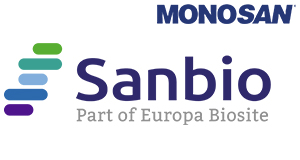Mouse anti-Hu CD20 Purified, clone LT20 (Monoclonal)
Mouse anti-Hu CD20 Purified, clone LT20 (Monoclonal)
Artikelnummer
SANMON23135
Verpackungseinheit
0,1 mg
Hersteller
Sanbio / Monosan
Verfügbarkeit:
wird geladen...
Preis wird geladen...
Clone Number: LT20
Immunogen: Normal human lymphocytes from lymph node.
Concentration: 1 mg/ml
Format: Purified by protein-A affinity chromatography.
Storage buffer: Phosphate buffered saline (PBS), pH 7.4, 15 mM sodium azide
Additional info: CD20 is a cell surface 33-37 (depending on the degree of phosphorylation) kDa non-glycosylated surface phosphoprotein expressed on mature and most malignant B cells, but not stem cells or plasma cells (low number of the CD20 has been also detected on a subpopulation of T lymphocytes and it can be expressed on follicular dendritic cells). Its expression on B cells is synchronous with the expression of surface IgM. CD20 regulates transmembrane calcium conductance (probably functioning as a component of store-operated calcium channel), cell cycle progression and B-cell proliferation. It is associated with lipid rafts, but the intensity of this association depends on extracellular triggering, employing CD20 conformational change and/or BCR (B cell antigen receptor) aggregation. After the receptor ligation, BCR and CD20 colocalize and then rapidly dissociate before BCR endocytosis, whereas CD20 remains at the cell surface. CD20 serves as a useful target for antibody-mediated therapeutic depletion of B cells, as it is expressed at high levels on most B-cell malignancies, but does not become internalized or shed from the plasma membrane following mAb treatment.SpecificityThe mouse monoclonal antibody OX-104 recognizes an extracellular epitope of CD200, a type-1 glycoprotein of the immunoglobulin superfamily, which is expressed in neurons, B and T cell subsets, keratinocytes, follicular dendritic cells, and ovarian cells.Application detailsFlow cytometry: Recommended dilution: 3 μg/ml.
Immunogen: Normal human lymphocytes from lymph node.
Concentration: 1 mg/ml
Format: Purified by protein-A affinity chromatography.
Storage buffer: Phosphate buffered saline (PBS), pH 7.4, 15 mM sodium azide
Additional info: CD20 is a cell surface 33-37 (depending on the degree of phosphorylation) kDa non-glycosylated surface phosphoprotein expressed on mature and most malignant B cells, but not stem cells or plasma cells (low number of the CD20 has been also detected on a subpopulation of T lymphocytes and it can be expressed on follicular dendritic cells). Its expression on B cells is synchronous with the expression of surface IgM. CD20 regulates transmembrane calcium conductance (probably functioning as a component of store-operated calcium channel), cell cycle progression and B-cell proliferation. It is associated with lipid rafts, but the intensity of this association depends on extracellular triggering, employing CD20 conformational change and/or BCR (B cell antigen receptor) aggregation. After the receptor ligation, BCR and CD20 colocalize and then rapidly dissociate before BCR endocytosis, whereas CD20 remains at the cell surface. CD20 serves as a useful target for antibody-mediated therapeutic depletion of B cells, as it is expressed at high levels on most B-cell malignancies, but does not become internalized or shed from the plasma membrane following mAb treatment.SpecificityThe mouse monoclonal antibody OX-104 recognizes an extracellular epitope of CD200, a type-1 glycoprotein of the immunoglobulin superfamily, which is expressed in neurons, B and T cell subsets, keratinocytes, follicular dendritic cells, and ovarian cells.Application detailsFlow cytometry: Recommended dilution: 3 μg/ml.
| Artikelnummer | SANMON23135 |
|---|---|
| Hersteller | Sanbio / Monosan |
| Hersteller Artikelnummer | MON23135 |
| Verpackungseinheit | 0,1 mg |
| Mengeneinheit | STK |
| Reaktivität | Human |
| Klonalität | Monoclonal |
| Methode | Flow Cytometry |
| Isotyp | IgG2a |
| Wirt | Mouse |
| Konjugat | Unconjugated |
| Produktinformation (PDF) |
|
| MSDS (PDF) |
|

 English
English







